Ecological Management Zoning Through Integration of Ecosystem Service and Landscape Ecological Risk: A Case Study in Chongli, China
Abstract
1. Introduction
2. Materials and Methods
2.1. Study Area
2.2. Data Sources and Preprocessing
2.3. Ecosystem Service Value (ESV) Assessment
2.4. Landscape Ecological Risk Index (LERI) Calculation
2.5. Spatial Autocorrelation Analysis
2.6. Ecological Management Zoning Analysis
3. Results
3.1. Land Use/Land Cover (LULC) Dynamics
3.2. Ecosystem Service Value (ESV) Changes
3.3. Landscape Ecological Risk Index (LERI) Patterns
3.4. ESV-LERI Spatial Correlation
3.5. Ecological Management Zoning
4. Discussion
4.1. Land Use and Ecosystem Service Value Dynamics: Vegetation Restoration and Shifts as Key Drivers
4.2. Landscape Ecological Risk Reduction: Evidence of Changes Indicating Enhanced Landscape Stability
4.3. ESV-LERI Correlation and Spatial Patterns: Reinforcing the Ecosystem Service-Risk Nexus
4.4. Olympic Construction as an Ecological Catalyst: Considering the Role of Mega-Event Driven Greening
4.5. Management Implications for Sustainable Development: Towards an Integrated Zoning Framework
4.6. Limitations and Future Research: Refining Methodologies and Expanding Scope
5. Conclusions
Author Contributions
Funding
Data Availability Statement
Conflicts of Interest
Correction Statement
Appendix A
| ES Type | Sub-Type | Shrub-Grassland | Barren Land | Deciduous Broad-Leaf Forest | Deciduous Coniferous Forest | Cropland | Water Body | Sum | |||||||
|---|---|---|---|---|---|---|---|---|---|---|---|---|---|---|---|
| 2016 | 2021 | 2016 | 2021 | 2016 | 2021 | 2016 | 2021 | 2016 | 2021 | 2016 | 2021 | 2016 | 2021 | ||
| Provisioning Services | FS | 3,348,953 | 3,775,999 | 0 | 0 | 718,085 | 798,997 | 359,238 | 233,464 | 1,474,407 | 0 | 2116 | 5930 | 5,902,798 | 4,814,390 |
| RMS | 4,935,299 | 5,564,629 | 0 | 0 | 1,634,262 | 1,818,406 | 849,108 | 551,825 | 693,838 | 0 | 608 | 1705 | 8,113,116 | 7,936,565 | |
| WS | 273,2040 | 3,080,420 | 0 | 0 | 841,893 | 936,755 | 440,883 | 286,524 | 34,692 | 0 | 21,925 | 61,453 | 4,071,433 | 4,365,152 | |
| Regulating Services | AQR | 17,361,675 | 19,575,571 | 11,563 | 28,099 | 5,373,256 | 5,978,700 | 2,775,931 | 1,804,042 | 1,162,179 | 0 | 2036 | 5708 | 26,686,640 | 27,392,119 |
| CR | 45,915,903 | 51,770,927 | 0 | 0 | 16,095,006 | 17,908,548 | 8,278,805 | 5,380,289 | 624,455 | 0 | 6056 | 16,976 | 70,920,225 | 75,076,739 | |
| EP | 15,158,417 | 17,091,362 | 57,813 | 140,494 | 4,778,979 | 5,317,461 | 2,433,022 | 1,581,189 | 173,460 | 0 | 14,678 | 41,142 | 22,616,368 | 24,171,647 | |
| WFR | 33,665,787 | 37,958,722 | 17,344 | 42,148 | 11,736,974 | 13,059,464 | 5,453,888 | 3,544,411 | 468,341 | 0 | 270,394 | 757,893 | 51,612,727 | 55,362,639 | |
| Supporting Services | SC | 21,151,280 | 23,848,412 | 11,563 | 28,099 | 6,561,810 | 7,301,177 | 3,363,775 | 2,186,074 | 1,786,634 | 0 | 2460 | 6894 | 32,877,521 | 33,370,655 |
| NC | 1,586,346 | 1,788,631 | 0 | 0 | 495,231 | 551,032 | 261,264 | 169,792 | 208,152 | 0 | 185 | 519 | 2,551,178 | 2,509,974 | |
| HQ | 19,212,412 | 21,662,307 | 11,563 | 28,099 | 5,967,533 | 6,639,938 | 3,069,853 | 1,995,058 | 225,498 | 0 | 6744 | 18,903 | 28,493,602 | 30,344,305 | |
| Cultural Services | LA | 8,460,512 | 9,539,365 | 5781 | 14,049 | 2,624,724 | 2,920,471 | 1,338,978 | 870,185 | 104,076 | 0 | 4999 | 14,010 | 12,539,070 | 13,358,080 |
References
- Sarkodie, S.A.; Owusu, P.A.; Leirvik, T. Global effect of urban sprawl, industrialization, trade and economic development on carbon dioxide emissions. Env. Res. Lett. 2020, 15, 34049. [Google Scholar] [CrossRef]
- Haase, D.; Larondelle, N.; Andersson, E.; Artmann, M.; Borgström, S.; Breuste, J.; Gomez-Baggethun, E.; Gren, Å.; Hamstead, Z.; Hansen, R.; et al. A quantitative review of urban ecosystem service assessments: Concepts, models, and implementation. Ambio 2014, 43, 413–433. [Google Scholar] [CrossRef] [PubMed]
- Liu, G.; Bian, S.; Lu, X. Green technologies behind the Beijing 2022 Olympic and Paralympic winter games. Env. Sci. Ecotechnol. 2023, 16, 100262. [Google Scholar] [CrossRef] [PubMed]
- Costanza, R.; d’Arge, R.; De Groot, R.; Farber, S.; Grasso, M.; Hannon, B.; Limburg, K.; Naeem, S.; O’Neill, R.V.; Paruelo, J.; et al. The value of the world’s ecosystem services and natural capital. Nature 1997, 387, 253–260. [Google Scholar] [CrossRef]
- Hamel, P.; Guerry, A.D.; Polasky, S.; Han, B.; Douglass, J.A.; Hamann, M.; Janke, B.; Kuiper, J.J.; Levrel, H.; Liu, H.; et al. Mapping the benefits of nature in cities with the InVEST software. Npj Urban Sustain. 2021, 1, 25. [Google Scholar] [CrossRef]
- Bagstad, K.J.; Johnson, G.W.; Voigt, B.; Villa, F. Spatial dynamics of ecosystem service flows: A comprehensive approach to quantifying, mapping, and modeling. Ecosyst. Serv. 2013, 4, 117–125. [Google Scholar] [CrossRef]
- Hein, L.; Van Koppen, K.; De Groot, R.S.; Van Ierland, E.C. Spatial scales, stakeholders and the valuation of ecosystem services. Ecol. Econ. 2006, 57, 209–228. [Google Scholar] [CrossRef]
- Schröter, M.; Van der Zanden, E.H.; Van Oudenhoven, A.P.; Remme, R.P.; Serna-Chavez, H.M.; De Groot, R.S.; Opdam, P. Ecosystem services as a contested concept: A synthesis of critique and counter-arguments. Conserv. Lett. 2014, 7, 514–523. [Google Scholar] [CrossRef]
- Ran, P.; Hu, S.; Frazier, A.E.; Qu, S.; Yu, D.; Tong, L. Exploring changes in landscape ecological risk in the Yangtze River Economic Belt from a spatiotemporal perspective. Ecol. Indic. 2022, 137, 108744. [Google Scholar] [CrossRef]
- Zou, Y.; Wang, S.; Luo, X.; Jin, H.; Xiao, X.; Li, Y. A new multivariate index for ecological. Sustain. Cities Soc. 2024, 364, 105442. [Google Scholar]
- Verburg, P.H.; Soepboer, W.; Veldkamp, A.; Limpiada, R.; Espaldon, V.; Mastura, S.S.A. Modeling the spatial dynamics of regional land use: The CLUE-S model. Env. Manag. 2002, 30, 391–405. [Google Scholar] [CrossRef] [PubMed]
- Liao, G.; He, P.; Gao, X.; Lin, Z.; Huang, C.; Zhou, W.; Deng, O.; Xu, C.; Deng, L. Land use optimization of rural production–living–ecological space at different scales based on the BP–ANN and CLUE–S models. Ecol. Indic. 2022, 137, 108710. [Google Scholar] [CrossRef]
- Wang, L.; Ma, S.; Zhao, Y.; Zhang, J. Ecological restoration projects did not increase the value of all ecosystem services in Northeast China. Ecol. Manag. 2021, 495, 119340. [Google Scholar] [CrossRef]
- Sannigrahi, S.; Chakraborti, S.; Joshi, P.K.; Keesstra, S.; Sen, S.; Paul, S.K.; Kreuter, U.P.; Sutton, P.C.; Jha, S.; Dang, K.B. Ecosystem service value assessment of a natural reserve region for strengthening protection and conservation. J. Environ. Manag. 2019, 244, 208–227. [Google Scholar] [CrossRef]
- Jiang, W.; Lü, Y.; Liu, Y.; Gao, W. Ecosystem service value of the Qinghai-Tibet Plateau significantly increased during 25 years. Ecosyst. Serv. 2020, 44, 101146. [Google Scholar] [CrossRef]
- Shi, J.; Li, S.; Song, Y.; Zhou, N.; Guo, K.; Bai, J. How socioeconomic factors affect ecosystem service value: Evidence from China. Ecol. Indic. 2022, 145, 109589. [Google Scholar] [CrossRef]
- Xu, W.; Wang, J.; Zhang, M.; Li, S. Construction of landscape ecological network based on landscape ecological risk assessment in a large-scale opencast coal mine area. J. Clean. Prod. 2021, 286, 125523. [Google Scholar] [CrossRef]
- Luo, F.; Liu, Y.; Peng, J.; Wu, J. Assessing urban landscape ecological risk through an adaptive cycle framework. Landsc. Urban Plann. 2018, 180, 125–134. [Google Scholar] [CrossRef]
- Du, L.; Dong, C.; Kang, X.; Qian, X.; Gu, L. Spatiotemporal evolution of land cover changes and landscape ecological risk assessment in the Yellow River Basin, 2015–2020. J. Env. Manag. 2023, 332, 117149. [Google Scholar] [CrossRef]
- Li, J.; Hu, D.; Wang, Y.; Chu, J.; Yin, H.; Ma, M. Study of identification and simulation of ecological zoning through integration of landscape ecological risk and ecosystem service value. Sustain. Cities Soc. 2024, 107, 105442. [Google Scholar] [CrossRef]
- Guo, H.; Cai, Y.; Li, B.; Yang, Z.; Liu, Y. An improved approach for evaluating landscape ecological risks and exploring its coupling coordination with ecosystem services. J. Env. Manag. 2023, 348, 119277. [Google Scholar] [CrossRef] [PubMed]
- Gong, J.; Cao, E.; Xie, Y.; Xu, C.; Li, H.; Yan, L. Integrating ecosystem services and landscape ecological risk into adaptive management: Insights from a semi-arid area, China. J. Environ. Manag. 2021, 288, 112417. [Google Scholar]
- Müller, M. What makes an event a mega-event? Definitions and sizes. Leis. Stud. 2015, 34, 627–642. [Google Scholar] [CrossRef]
- Preuss, H. The conceptualisation and measurement of mega sport event legacies. J. Sport Tour. 2007, 12, 207–228. [Google Scholar] [CrossRef]
- Belgiu, M.; Drăguţ, L. Random forest in remote sensing: A review of applications and future directions. ISPRS J. Photogramm. Remote Sens. 2016, 114, 24–31. [Google Scholar] [CrossRef]
- Gislason, P.O.; Benediktsson, J.A.; Sveinsson, J.R. Random forests for land cover classification. Pattern Recognit. Lett. 2006, 27, 294–300. [Google Scholar] [CrossRef]
- Congalton, R.G. A review of assessing the accuracy of classifications of remotely sensed data. Remote Sens. Environ. 1991, 37, 35–46. [Google Scholar] [CrossRef]
- Xie, G.; Zhang, C.; Zhen, L.; Zhang, L. Dynamic changes in the value of China’s ecosystem services. Ecosyst. Serv. 2017, 26, 146–154. [Google Scholar] [CrossRef]
- Li, M.; Zhang, L.; Chen, Y.; Liu, S.; Cai, M.; Sun, Q. Construction of Landscape Ecological Risk Collaborative Management Network in Mountainous Cities—A Case Study of Zhangjiakou. Land 2024, 13, 1586. [Google Scholar] [CrossRef]
- Ai, J.; Yu, K.; Zeng, Z.; Yang, L.; Liu, Y.; Liu, J. Assessing the dynamic landscape ecological risk and its driving forces in an island city based on optimal spatial scales: Haitan Island, China. Ecol. Indic. 2022, 137, 108771. [Google Scholar] [CrossRef]
- Chen, J.; Yang, Y.; Feng, Z.; Huang, R.; Zhou, G.; You, H.; Han, X. Ecological risk assessment and prediction based on scale optimization—A case study of Nanning, a landscape garden city in China. Remote Sens. 2023, 15, 1304. [Google Scholar] [CrossRef]
- McGarigal, K. FRAGSTATS: Spatial Pattern Analysis Program for Quantifying Landscape Structure; US Department of Agriculture: Washington DC, USA; Forest Service: Missoula, MT, USA; Pacific Northwest Research Station: Portland, OR, USA, 1995; Volume 351. [Google Scholar]
- Fardila, D.; Kelly, L.T.; Moore, J.L.; McCarthy, M.A. A systematic review reveals changes in where and how we have studied habitat loss and fragmentation over 20 years. Biol. Conserv. 2017, 212, 130–138. [Google Scholar] [CrossRef]
- Banks-Leite, C.; Ewers, R.M.; Folkard-Tapp, H.; Fraser, A. Countering the effects of habitat loss, fragmentation, and degradation through habitat restoration. One Earth 2020, 3, 672–676. [Google Scholar] [CrossRef]
- Yu, J.; Tang, B.; Chen, Y.; Zhang, L.; Nie, Y.; Deng, W. Landscape ecological risk assessment and ecological security pattern construction in landscape resource-based city: A case study of Zhangjiajie City. Acta Ecol. Sin. 2022, 42, 1290–1299. [Google Scholar]
- Chen, X.; Xie, G.; Zhang, J. Landscape ecological risk assessment of land use changes in the coastal area of Haikou City in the past 30 years. Acta Ecol. Sin. 2021, 41, 975–986. [Google Scholar]
- Anselin, L.; Syabri, I.; Kho, Y. GeoDa: An introduction to spatial data analysis. Geog. Anal. 2006, 38, 5–22. [Google Scholar] [CrossRef]
- Ma, Y.; Liu, Y.; López-Vicente, M.; Wu, G.L. Divergent shift of normal alpine meadow towards shrub and degraded meadows reduces soil water retention and storage capacity. J. Hydrol. 2023, 625, 130109. [Google Scholar] [CrossRef]
- Zhang, Y.; Xu, Z.; Wu, J. Influence of Beijing Winter Olympic Games construction on vegetation coverage around Zhangjiakou competition zone. Int. J. Environ. Res. Public Health 2021, 18, 12777. [Google Scholar] [CrossRef]
- Wang, Z.; Zhang, L.; Li, X.; Li, Y.; Fu, B. Integrating ecosystem service supply and demand into ecological risk assessment: A comprehensive framework and case study. Landsc. Ecol. 2021, 36, 2977–2995. [Google Scholar] [CrossRef]
- Li, Z.; Cheng, X.; Han, H. Future impacts of land use change on ecosystem services under different scenarios in the ecological conservation area, Beijing, China. Forests 2020, 11, 584. [Google Scholar] [CrossRef]
- Cheng, Y.; Wu, H.; Yang, B. Conserving habitat and ecosystem in protected areas amid increasing intensive human modification: A case study of China’s Pan-Pearl River Delta. Ecol. Indic. 2023, 154, 110799. [Google Scholar] [CrossRef]
- Zhang, W.; Chang, W.; Zhu, Z.; Hui, Z. Landscape ecological risk assessment of Chinese coastal cities based on land use change. Appl. Geogr. 2020, 117, 102174. [Google Scholar] [CrossRef]
- Abson, D.J.; Termansen, M. Valuing ecosystem services in terms of ecological risks and returns. Conserv. Biol. 2011, 25, 250–258. [Google Scholar] [CrossRef] [PubMed]
- Keyes, A.A.; McLaughlin, J.P.; Barner, A.K.; Dee, L.E. An ecological network approach to predict ecosystem service vulnerability to species losses. Nat. Commun. 2021, 12, 1586. [Google Scholar] [CrossRef]
- Jiang, H.; Peng, J.; Dong, J.; Zhang, Z.; Xu, Z.; Meersmans, J. Linking ecological background and demand to identify ecological security patterns across the Guangdong-Hong Kong-Macao Greater Bay Area in China. Landsc. Ecol. 2021, 36, 2135–2150. [Google Scholar] [CrossRef]
- Bastin, J.F.; Finegold, Y.; Garcia, C.; Mollica, G.; Rezende, M.; Routh, D.; Zohner, C.M.; Crowther, T.W. The global tree restoration potential. Science 2019, 365, 76–79. [Google Scholar] [CrossRef]
- Fu, B.; Liu, Y.; Meadows, M.E. Ecological restoration for sustainable development in China. Natl. Sci. Rev. 2023, 10, nwad033. [Google Scholar] [CrossRef] [PubMed]
- Mitchell, M.G.; Devisscher, T. Strong relationships between urbanization, landscape structure, and ecosystem service multifunctionality in urban forest fragments. Landsc. Urban Plann. 2022, 228, 104548. [Google Scholar] [CrossRef]
- Backman, K.F. Event management research: The focus today and in the future. Tour. Manag. Perspect. 2018, 25, 169–171. [Google Scholar] [CrossRef]
- Selin, N.E.; Giang, A.; Clark, W.C. Progress in modeling dynamic systems for sustainable development. PNAS 2023, 120, e2216656120. [Google Scholar] [CrossRef]
- Littles, C.; Karnezis, J.; Blauvelt, K.; Creason, A.; Diefenderfer, H.; Johnson, G.; Krasnow, L.; Trask, P. Adaptive management of large-scale ecosystem restoration: Increasing certainty of habitat outcomes in the Columbia River estuary, USA. Restor. Ecol. 2022, 30, e13634. [Google Scholar] [CrossRef]
- Chen, W.; Gu, T.; Xiang, J.; Luo, T.; Zeng, J.; Yuan, Y. Ecological restoration zoning of territorial space in China: An ecosystem health perspective. J. Env. Manag. 2024, 364, 121371. [Google Scholar] [CrossRef] [PubMed]
- Berkes, F. Sacred Ecology; Routledge: Abingdon, UK, 2017. [Google Scholar]
- Agbedahin, A.V. Sustainable development, Education for Sustainable Development, and the 2030 Agenda for Sustainable Development: Emergence, efficacy, eminence, and future. Sustain. Dev. 2019, 27, 669–680. [Google Scholar] [CrossRef]
- Wu, J. Effects of changing scale on landscape pattern analysis: Implications for scaling relations. Landsc. Ecol. 2004, 19, 125–138. [Google Scholar] [CrossRef]
- Wilson, M.A.; Hoehn, J.P. Valuing environmental goods and services using benefit transfer: The state-of-the-art and science needs. Ecol. Econ. 2006, 60, 335–342. [Google Scholar] [CrossRef]
- Watts, K.; Whytock, R.C.; Park, K.J.; Fuentes-Montemayor, E.; Macgregor, N.A.; Duffield, S.; McGowan, P.J. Ecological time lags and the journey towards conservation success. Nat. Ecol. Evol. 2020, 4, 304–311. [Google Scholar] [CrossRef]
- Feng, Z.; Jin, X.; Chen, T.; Wu, J. Understanding trade-offs and synergies of ecosystem services to support the decision-making in the Beijing–Tianjin–Hebei region. Land Use Policy 2021, 106, 105446. [Google Scholar] [CrossRef]
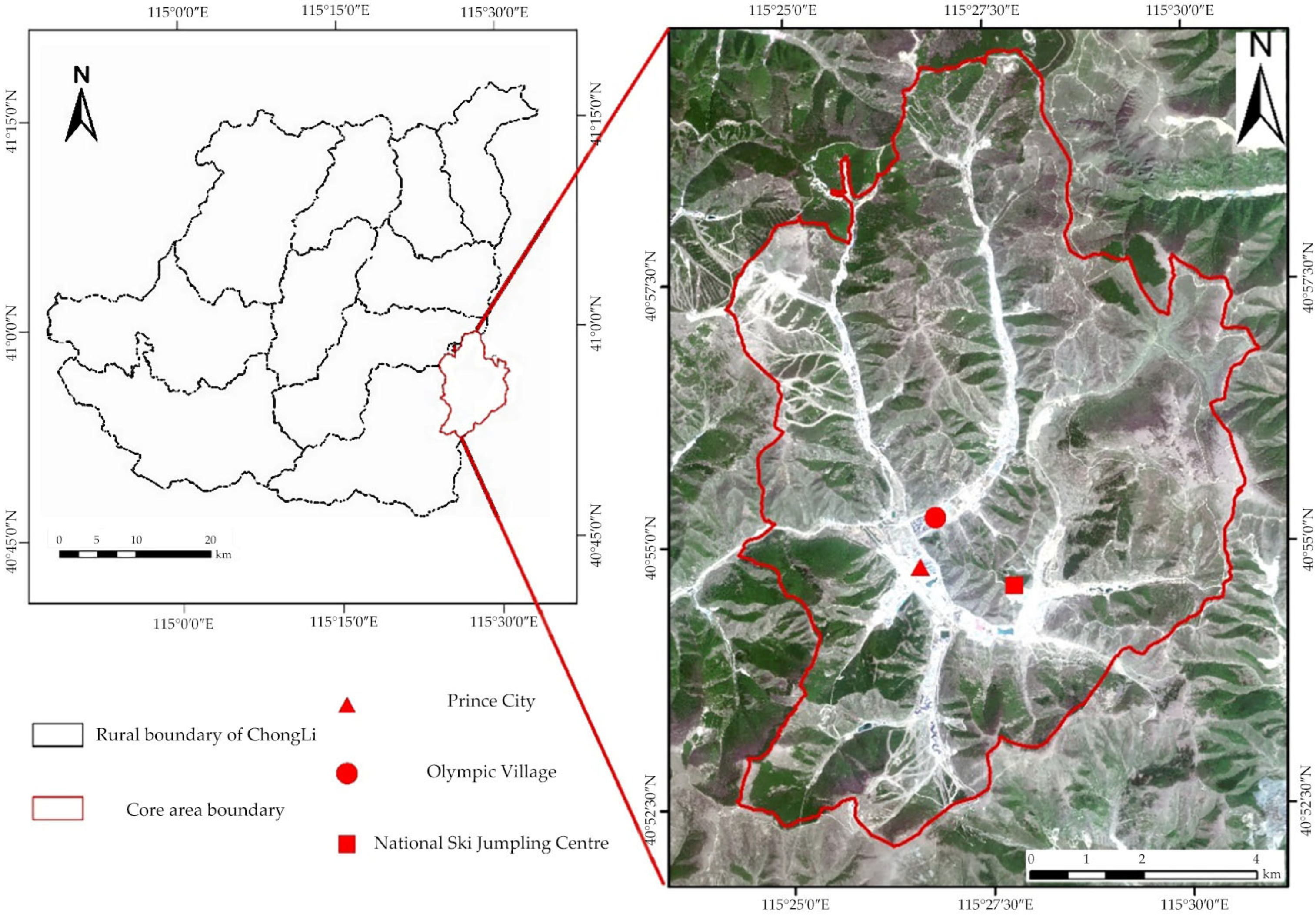
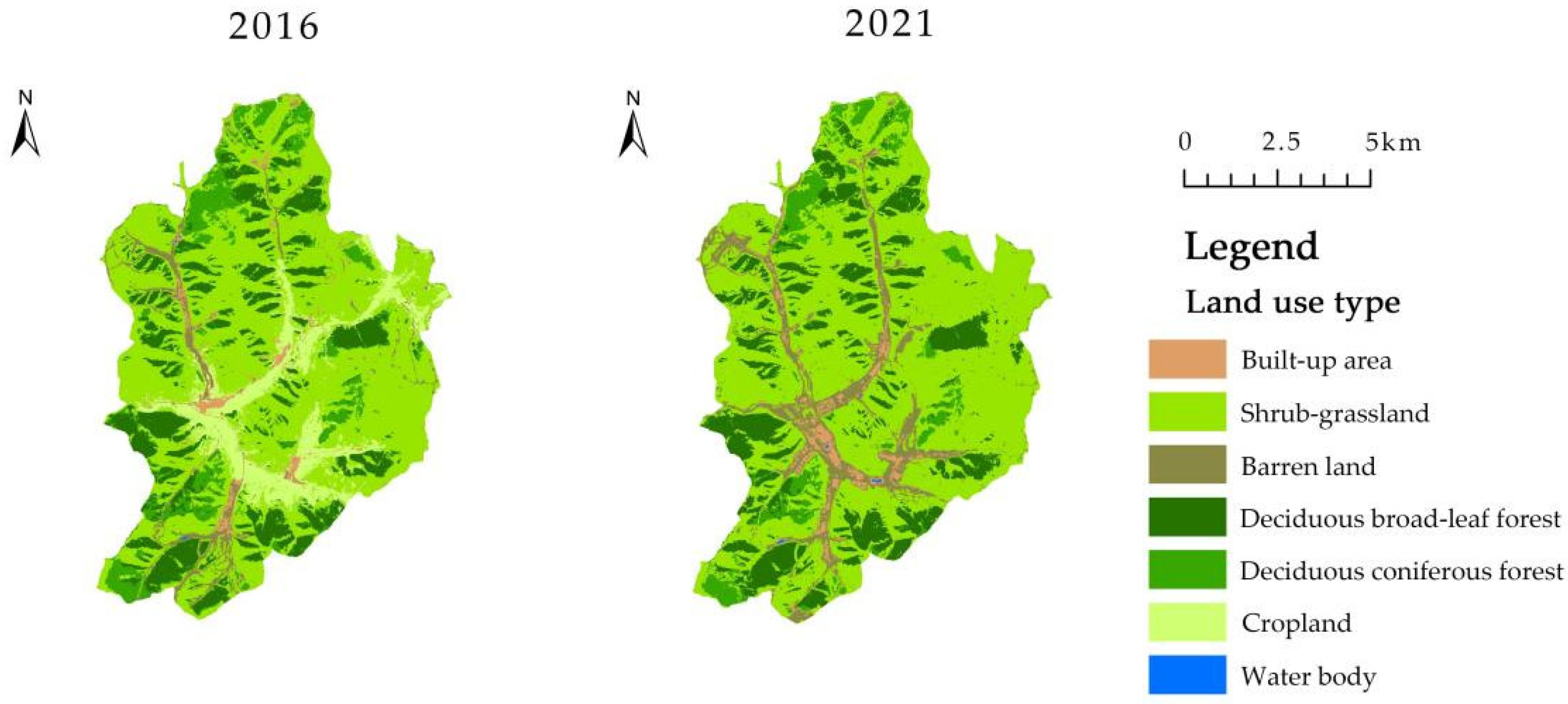
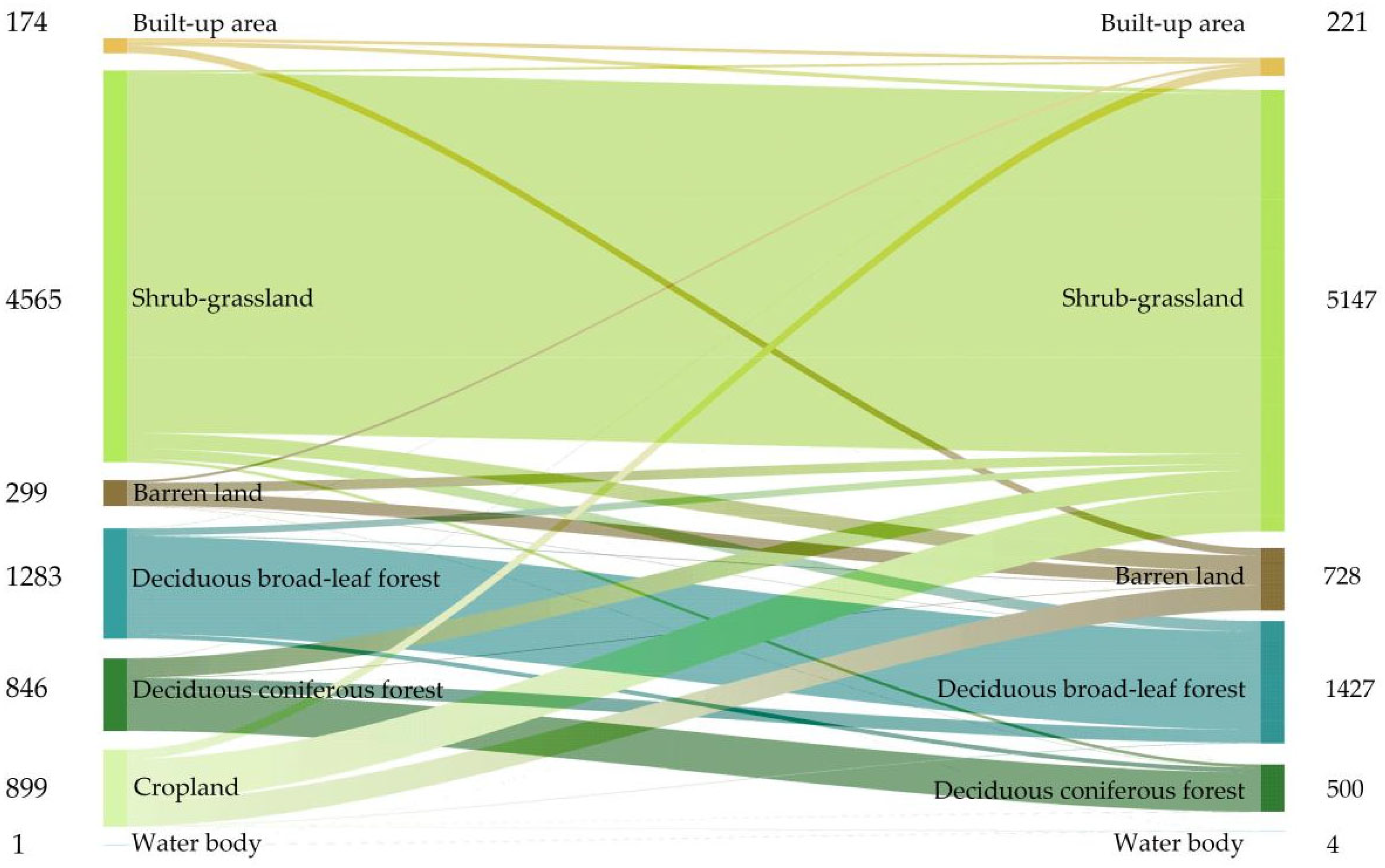
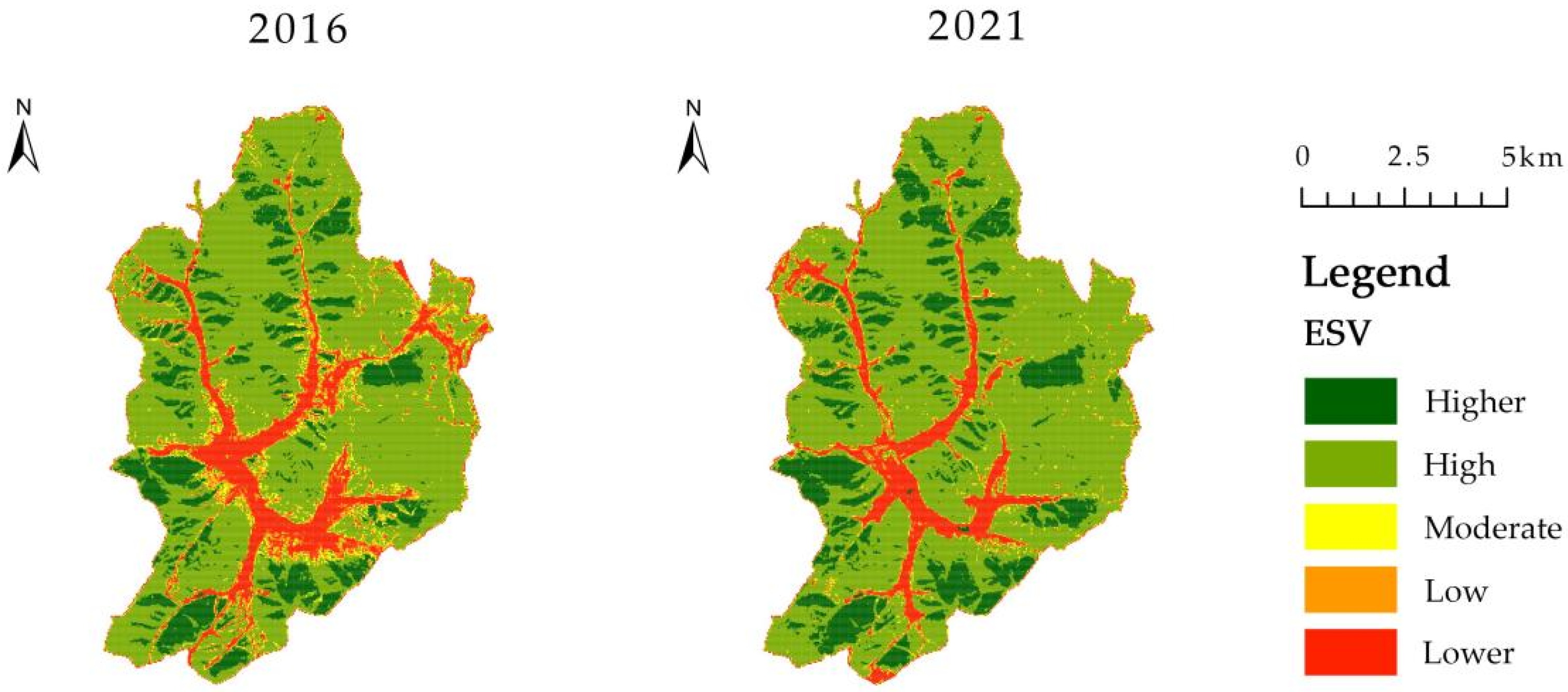
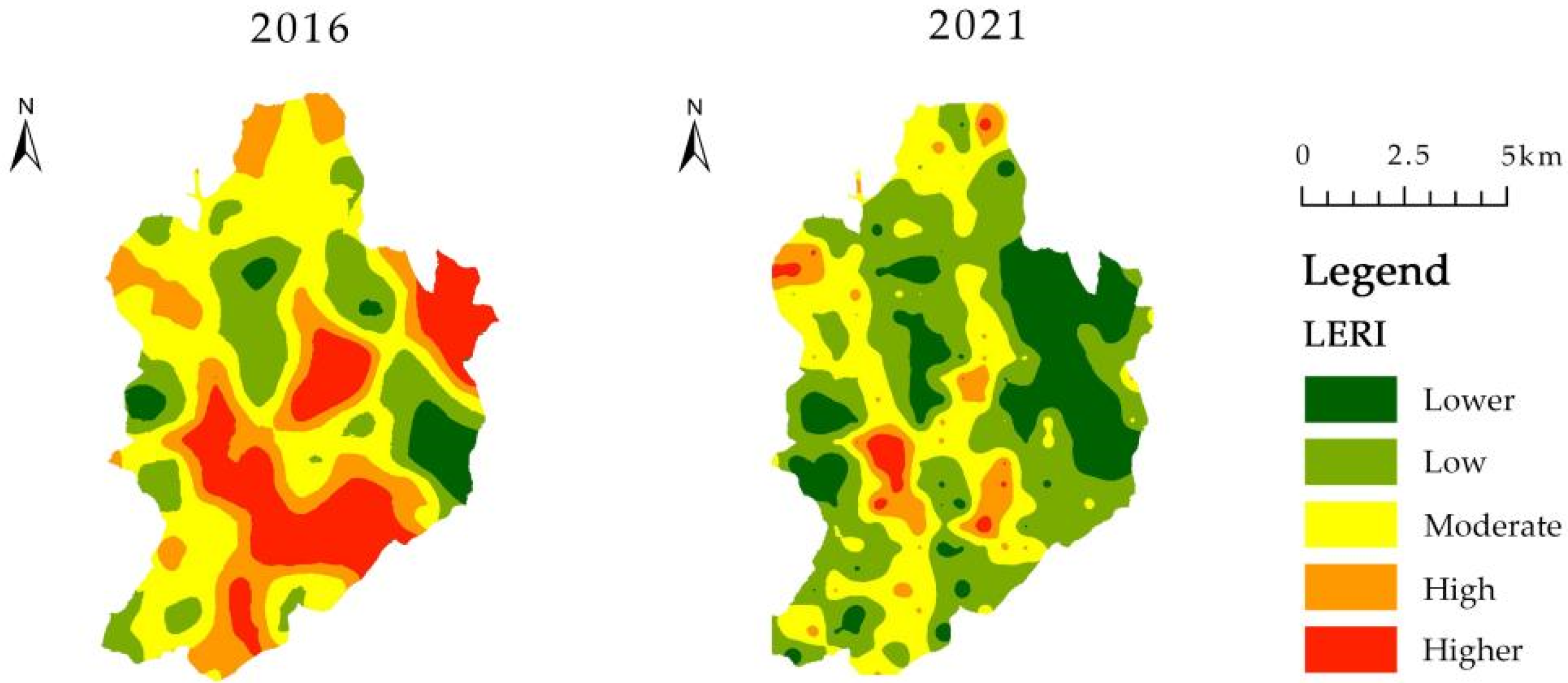



| ES Type | ES Sub-Type | Shrub-Grassland | Barren Land | Deciduous Broad-Leaf Forest | Deciduous Coniferous Forest | Cropland | Water Body |
|---|---|---|---|---|---|---|---|
| Provisioning Services | FS | 733.57 | 0.00 | 559.83 | 424.70 | 1640.87 | 1544.35 |
| RMS | 1081.05 | 0.00 | 1274.09 | 1003.83 | 772.18 | 444.00 | |
| WS | 598.44 | 0.00 | 656.35 | 521.22 | 38.61 | 16,003.34 | |
| Regulating Services | AQR | 3802.97 | 38.61 | 4189.05 | 3281.75 | 1293.39 | 1486.44 |
| CR | 10,057.59 | 0.00 | 12,547.86 | 9787.33 | 694.96 | 4420.71 | |
| EP | 3320.36 | 193.04 | 3725.75 | 2876.35 | 193.04 | 10,713.94 | |
| WFR | 7374.28 | 57.91 | 9150.28 | 6447.67 | 521.22 | 197,368.12 | |
| Supporting Services | SC | 4633.05 | 38.61 | 5115.66 | 3976.71 | 1988.35 | 1795.31 |
| NC | 347.48 | 0.00 | 386.09 | 308.87 | 231.65 | 135.13 | |
| HQ | 4208.36 | 38.61 | 4652.36 | 3629.23 | 250.96 | 4922.62 | |
| Cultural Services | LA | 1853.22 | 19.30 | 2046.27 | 1582.96 | 115.83 | 3648.53 |
| Land-Use Type | Land-Use Area (hm2) | Change Proportion (%) | |
|---|---|---|---|
| 2016 | 2021 | 2016–2021 | |
| Deciduous coniferous forest | 845.87 | 549.72 | −35.0 |
| Deciduous broad-leaf forest | 1282.69 | 1427.22 | 11.27 |
| Shrub-grassland | 4565.3 | 5147.45 | 12.75 |
| Built-up area | 173.96 | 211.31 | 21.47 |
| Water body | 1.47 | 3.84 | 161.22 |
| Barren land | 299.48 | 727.78 | 143.01 |
| Cropland | 898.55 | 0 | −100 |
| Year | Shrub -Grassland | Barren Land | Deciduous Broad-Leaf Forest | Deciduous Coniferous Forest | Cropland | Water Body | Sum | |
|---|---|---|---|---|---|---|---|---|
| ESV (CNY) | 2016 | 173,528,623.1 | 115,625.6 | 56,827,752.7 | 28,624,744.7 | 6,955,729.8 | 332,201.0 | 266,384,676.7 |
| 2021 | 195,656,344.8 | 280,987.0 | 63,230,948.4 | 18,602,852.3 | 0 | 931,132.6 | 278,702,265.0 | |
| ESV change (CNY) | 2016–2021 | 22,127,721.7 | 165,361.4 | 6,403,195.7 | −10,021,892.4 | −6,955,729.8 | 598,931.6 | 12,317,588.2 |
| Change proportion (%) | 2016–2021 | 12.8% | 143.0% | 11.3% | −35.0% | −100% | 180.3% | 4.6% |
| Year | Provisioning Services | Regulating Services | Supporting Services | Cultural Services | Total ESV | |
|---|---|---|---|---|---|---|
| ESV (CNY) | 2016 | 18,087,346.1 | 171,835,960.3 | 63,922,300.6 | 12,539,069.8 | 266,384,676.7 |
| 2021 | 17,116,106.7 | 182,003,143.7 | 66,224,934.6 | 13,358,080.0 | 278,702,265.0 | |
| ESV change (CNY) | 2016–2021 | −971,239.4 | 10,167,183.4 | 2,302,634.0 | 819,010.2 | 12,317,588.2 |
| Change proportion (%) | 2016–2021 | −5.4 | 5.9 | 3.6 | 6.5 | 4.6 |
| Year | Lower ESV | Low ESV | Moderate ESV | High ESV | Higher ESV | |||||
|---|---|---|---|---|---|---|---|---|---|---|
| Area (hm2) | Proportion (%) | Area (hm2) | Proportion (%) | Area (hm2) | Proportion (%) | Area (hm2) | Proportion (%) | Area (hm2) | Proportion (%) | |
| 2016 | 5,772,622.9 | 7.3 | 3,046,662.1 | 3.9 | 2,373,189.4 | 3.0 | 42,781,549.4 | 54.2 | 24,958,576.3 | 31.6 |
| 2021 | 5,483,991.7 | 7.0 | 2,565,610.2 | 3.3 | 3,118,819.8 | 4.0 | 43,807,793.4 | 55.5 | 23,956,384.9 | 30.4 |
| 2016–2021 | −288,631.1 | −0.3 | −481,051.9 | −0.6 | 745,630.5 | 1.0 | 1,026,244.1 | 1.3 | −1,002,191.5 | −1.2 |
| Year | Lower LERI | Low LERI | Moderate LERI | High LERI | Higher LERI | |||||
|---|---|---|---|---|---|---|---|---|---|---|
| Area (hm2) | Proportion (%) | Area (hm2) | Proportion (%) | Area (hm2) | Proportion (%) | Area (hm2) | Proportion (%) | Area (hm2) | Proportion (%) | |
| 2016 | 3,669,260.1 | 4.65% | 16,556,157.3 | 20.98% | 28,329,561.7 | 35.89% | 15,867,271.7 | 20.10% | 14,510,349.3 | 18.38% |
| 2021 | 16,442,717.7 | 20.83% | 34,533,799.5 | 43.75% | 21,907,719.7 | 27.75% | 4,848,488.6 | 6.14% | 1,199,874.5 | 1.52% |
| 2016–2021 | 12,773,457.6 | 16.18% | 17,977,642.2 | 22.78% | −6,421,842.0 | −8.14% | −11,018,783.1 | −13.96% | −13,310,474.7 | −16.86% |
Disclaimer/Publisher’s Note: The statements, opinions and data contained in all publications are solely those of the individual author(s) and contributor(s) and not of MDPI and/or the editor(s). MDPI and/or the editor(s) disclaim responsibility for any injury to people or property resulting from any ideas, methods, instructions or products referred to in the content. |
© 2025 by the authors. Licensee MDPI, Basel, Switzerland. This article is an open access article distributed under the terms and conditions of the Creative Commons Attribution (CC BY) license (https://creativecommons.org/licenses/by/4.0/).
Share and Cite
Xu, F.; Yan, S.; Wang, X.; Wang, X. Ecological Management Zoning Through Integration of Ecosystem Service and Landscape Ecological Risk: A Case Study in Chongli, China. Land 2025, 14, 1133. https://doi.org/10.3390/land14061133
Xu F, Yan S, Wang X, Wang X. Ecological Management Zoning Through Integration of Ecosystem Service and Landscape Ecological Risk: A Case Study in Chongli, China. Land. 2025; 14(6):1133. https://doi.org/10.3390/land14061133
Chicago/Turabian StyleXu, Fang, Shaoning Yan, Xiangrong Wang, and Xiyue Wang. 2025. "Ecological Management Zoning Through Integration of Ecosystem Service and Landscape Ecological Risk: A Case Study in Chongli, China" Land 14, no. 6: 1133. https://doi.org/10.3390/land14061133
APA StyleXu, F., Yan, S., Wang, X., & Wang, X. (2025). Ecological Management Zoning Through Integration of Ecosystem Service and Landscape Ecological Risk: A Case Study in Chongli, China. Land, 14(6), 1133. https://doi.org/10.3390/land14061133





